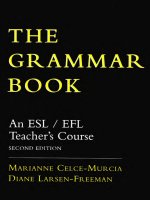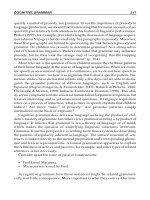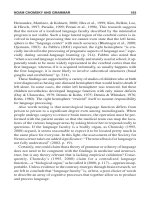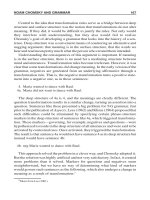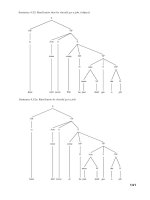The teacher''''s magazine - merry christmas !
Bạn đang xem bản rút gọn của tài liệu. Xem và tải ngay bản đầy đủ của tài liệu tại đây (2.26 MB, 32 trang )
hifli
re
aueeaCe,
B
a
6ecaue we lLWe
?or9oLten
we
tIU
Actions
TO EATTO BLOW
MA
It's wintertime!
Global Culture Corner:
I
World AIDS day
Emperor's Birthday
-
Japan
Tr
; i )
1
r,
lilt
&nthe communtti
@CkIbEDIBA
I
WWW.CU6.A1L.CABTh
Best
•
Teacher store in Valencia
•
Shop online
•
We
deliver anywhere in Spain
and Portugal
•
The best way to motivate your
students!
$ ___
Books
Incentives
Stickers
F:
M
Music
Classroom decorations
Games
c/ Miguel Navarro, 4 46015 Volennia 9609108 24
f 01Y www.englishwooks.es
ear colleague,
Welcome to December's issue
of
The Teacher's Magazine.
This edition brings tots
of
ideas and materials to celebrate the
Christmas season and the beginning
of
winter. We are pleased to bring
you tips to prepare decorated gifts for the occasion and varied
photocopiable activities. In addition, we are offering a beautiful Nativity
scene you can assemble and use to adorn your classroom.
Colourful verb/action cards showing a wide array
of
activities that
students usually carry out at home offer great opportunities for
language teaching and practice.
Holiday Season greetings for everybody!
The Teacher's Magazine team
JjI
r
11
oF
.S7
M A
M,SS, PAFI,,M5/5 SA,ACN,AA!,.M.AAA
!
2PtI F
h,F,S
by F
MA
A
AF,P.W
BS.FMA G.AAO,
g
Ma
SF
!
M
I!
PA.FFMFMFMM
I
AFFMPSNAM AMy
FM,YIMA,,yMNy,,
A
1 FMa
,.IALAMAS,NAC
CIA
yASMq
I
I
CL AM
F
F
1.
0.5MM U
IF! FF03/I SPAIN P.511. SIrsdSS L
1,
r.
L CIA
AIM
MId
*
MSyM Pt
121,
III
MACNFl C
Al
MAA,C$ 35 51UM4A.M,l.3.ItF
F
A
51530PtF
SF55,510
(PAl Md IF
IN
/3(3050CM
Fl
Al
F
PALS
ES
CISCA
30AN*Mg
WA
PALES
.05*2 05,
*0
(FF50.15
S.,
IFS
GRUPO
EDIBA
Gotowwwed,b
020MAI*.TESdIAy,MMM.lM.
S
II
F A
AlA
S
pAls
FAA
A
MAN
AMy!
0'
2
Poland
/
www.ediba.com
Spain
Tel.:
+22 566 77 87
All
information inw::e.com
By
e-mail:
By
Phone:
913520918
By
Fax:
91 715 58 75
Czech Republic
Contact: www.send.cz
A FLURRY OF
ACTIVITIES
AT HOME
p.540
aster 1 presents a colourful array of activities
4,
1
that students usually carry out al home.
These verb/action cards can be the first stage
of leaching verbs to young learners of English.
The verbs on the poster are:
hug. listen, blow, jump,
paint,
cut,
wash, write, sing, read, smell, cook, iron, comb,
drink, eat.
These action/verb cards can be used in different ways. Here
you will find a guide of graded activities. Cut the cards Out and
rlaminate them.
Actions in a box
Put the cards into a box; put the lid on having previously
opened a slot big enough to allow children slip in a hand and
draw a picture. Volunteers will lake a card, have a look at it
without showing it to the class and mimic the action. The class
should call out the verb represented by their mate.
Challenge the students to make a sentence including the verb;
I
read a
story in
the
afternoon;
I
sing my
favourite
song;
I smell
flowers in the
garden,
My dad rooks on Sundays.
4
Actions and their frequency
Add frequency adverbs and time expressions to the previous
activity. The students go to the box, pick up a card and in
groups write sentences using the target expressions. (e.g.
I
often paint in
the
afternoon; I jump into ponds on rainy days; I
blow my candles once a year/on
my
birthday;
I always listen to
music on
the
radio; My mom irons our clothes once a week/on
Fridays.)
You could also add a second box with strips of paper holding
the frequency adverbs or time expressions you want to revise
and have the students draw a card from each box. They should
sellotape them on the board and write a sentence including
both cards.
Can you do this!
Put the cards in a pile on the desk. The students should pick
up a card and say the verb on it using
can,
e.g.
Iran write; I
can
cook; Iran
sing,
etc.
tithe student makes a mistake, they
must put the card hark on the pile. The activity goes on until
all the cards have been picked up.
Variant: Working in pairs, one student takes a card and asks,
Can you sing?
Their mate answers,
Yes, 1 can. / Na, I can't.
Do you like ?
Cut Out and laminate the images on poster 2,
or print and have students colour the
pictures on page 6, put them into a small
box and place it on the desk, next to the box
containing the cards of the poster. In turns,
the students go to
-
the front and take a card
from each box. Then, they should make
sentences like the following:
TT
U7
e4 '
L
Likes and dislikes interview
Students interview each other asking, Do
you like jumping?
Yes, Ido.
Shift to the third person singular and have the students speak
about their mum, dad, brother or sister. E.g.
Does your father
like cooking? Yes, he does. / No, he doesn't. Does your mother
like ironing your clothes? Yes, she does. / No, she doesn't.
Describing actions now'
Put the cards in the box and ask the students to take one card
at the time. They should describe the activity using
now/right
now.
•
The children orejsmping into a pond.
•
The man is cooking.
•
It's her birthday; she is blowing her birthday cake candle.
•
He is cutting out pictures.
•
He is eating a sandwich.
•
She is combing her hair.
Where do you ?
Start sentences for the students to complete mentioning the
rooms where the actions lake place. E.g.
I comb my hair in the
(bathroom).
What do you do when ?
Give the students some situations like I'm hungry/tired/thirsty,
etc. and have them pick up a card according to the situation
given and make up dialogues like these:
•
What do you do when you are tired? When I'm tired,
I listen
to music.
•
What do you do when you are hungry? When Ire hungry, teat a
sandwich.
•
What do you do when you are thirsty? When I'm thirsty, I drink some
water.
•
What do you do when you are
free?
When I'm free, ]jump!
Giving suggestions
Write a list
of
complaints on the board and ask the students to
pick a card and make an appropriate suggestion.
•
Mum! I'm bored?
Why don't you read a story?! You could paint!
•
Mum! I'm hungry!
Why don't you eatasandwich?
•
Mum! I'm thirsty!
Why don't you drink a gloss of water?
•
Mum! I'm nervous! Why don't you listen to soft music?
As a follow-up activity you will find some photocopiable
exercises on pages 7 to 9.
DO YOU LIKE ?
)
Level: Beginner
Age; All
MUM! IN BORED!
What is Mum saying?
Look at the pictures and give suggestions using
Whydon't you ?
:__
Keyt 1) Why don't you ploy football? 2) Why don't you go for o walk? 3) Why don't you hove a swim? 4)Why don't you read?
51
Why don't you do your
homework? 6)Why don't you dance? 7) Why don't you sing? 8) Why don't you cook?
Level: Beginner
Age:
All
WHAT DO YOU DO WHEN IT S RAINING
Look at the pictures and answer these questions with complete answers.
QD
0
oaf:
1) What do you do when you are tired?
1) .
n
,
2)Whatdoyou dowhen you are hungry?
2)
3) What do you do when you are thirsty?
3)
41 What do you do when you are sad?
4)
5)
What do you do on your birthday?
5)
6)
What do you do when you finish your homework?
6)
71 What do you do when your mum needs help?
7)
Key lnuggnnted answerslr 2)1 can when Ire hungry; 3)1 drink when rrn thirsty; 411 liuterrto music when or cad; 5)) blow the tandler on coy birthday;
6) Ilccrnp when I Crick coy homework 7)) iron the clothes when cry rnron reeds help.
I Levels Beginner
Age: All
HOW OFTEN DO YOU DO THIS ACTIVITY?
Ask and answer questions about the pictures. Use these adverbs of frequency in the box.
Example:
How
often do you smell flowers? I often smell flowers.
always - usually - often - sometimes - hardly ever - never
O
f,
Key (Suggested answers); 11 How often do you sIeep usually sleep 21 How often do you jump? I often jump. 3) How often do sooeat? I often eat. 4) How
often do you build walls) I never build walls. 5) How often do you do homework? I always do homework. 61 Howoftnsr do you watch TV? I hardly ever wntohTV,
.9
g
C
hristmas is a special time in most parts of the
world. It is a Christian holiday to celebrate the
birth of Jesus, and also an occasion to get
together with our family and friends.
In many countries it is common to set up the scene
of the Nativity in homes and churches. This is a small model
the stable where Jesus was born, with Mary, Joseph, Baby
Jesus, shepherds and animals.
For Christmas people decorate their homes with garlands,
bright red flowers called poinsettias, holly wreaths and
mistletoe. But the most popular symbol of the season is
the Christmas tree, decorated with lights, colourful
Ornaments and a star or an angel on top.
Poster 2 offers diverse materials to work on the
days before Christmas: two thematic pictures to
14
post on the classroom walls and a game for pair and
whole class activities, in which students must find
the differences between two Christmas trees.
Let's find the differences!
109
•
Laminate and cut out both pictures, and hang them on two
opposite classroom walls.
•
Divide the students into two groups and tell them to look at
their corresponding picture and memorise all the elements on
it.
•
After five minutes, remove the pictures and ask the
students to sit with a student from the other group.
•
Before interacting, each student should list all the
elements they recall from their picture.
•
Sitting opposite each other, they read their list in
turns while the other student ticks the
mentioned elements.
•
Finally, they compare both lists and find out
what is different between the pictures.
0
111
'ilk
4
-
___
Level
Age -
WHAT IS YOUR CHRISTMAS TREE LIKE?
Find the differences between your Christmas tree and your friends. Ask each other questions like:
•
Has your Christmas tree got a ?
•
Is there - . - ?/ Are there ?
*'•_
W,.,
Level: Beginner
Age: Children
WHAT IS YOUR CHRISTMAS TREE LIKE?
Find the differences
between your Christmas tree and your friends. Ask each other questions like:
•
Has your Christmas tree got a.
. Is there ?/ Are there.?
AWAY
I
Away in a manger, no crib for a bed
The little Lord Jesus lay down His sweet head.
a,hese verses from a popular Christmas song
A
f
are about the scene of the birth of Jesus in
a
•,
humble manger outside Bethlehem, where
'I. Jesus' parents, Mary and Joseph, travelled to
following orders from the Roman Emperor.
Find on pages 16 and 17 the pictures of the characters to cut
out and assemble a manger scene for the Christmas
celebration.
On the back of the coloured pictures (pages 15 and 18) the
same characters are presented in a photocopiable version in
case you want to have several sets of characters.
•L'
sO"
-
'semi
I
'H
i
1 i
'we all know, recycling and re-using plastic
Ask the students to bring empty plastic water and soda bottles
4,
bottles help to preserve the world's natural
they have at home. Tell them to remove their labels and wash
resources. So, before throwing away those
them beforehand.
.
3 empty bottles, we are going to raise awareness
of the importance of
present these crafts for Christm
recyclable once they wear away.
Treat little bottles
AWk
You will need: •
plastic soda
bottles • red and green fabric; red
•
green paper • ribbon
and green
. a hot glue gun
,
•
a sharp knife • sweets for
.
filling up the boxes.
How to:
I. Cut the bottoms off of the
plastic bottles using a sharp
knife to make the first cut and
then trim the bottles to desired
height.
_________
2.
Cut the necks off using the
_________
same procedure as in 1.
3.
Decorate with red fabric or red
paper hearts and circles and lengths of
ribbon.
4.
Fill the boxes up with sweets and put the cap
on.
S. The gift is ready lobe put under the Christmas
tree with a little card holding the name of the
addressee.
4t
/
.555
I
.
, ç
•' 0r
'l
ii
fs
2'
.4'
5- •'
•-
:
a
You will need: • red and white
construction or craft paper a pompom
beads • scissors • glue • big lollipops.
How to:
1.
Draw and cut out Santa's hat in red
construction paper.
2.
Glue the brim in white.
3.
Add the pompom.
4.
Glue the beads for the eyes.
5.
Draw and cot Out the beard in white.
6.
Glue it on the bottom of the lollipop.
7.
Write a message on the beard.
Santa in a big lollipop
A yummy Christmas
How to:
1.
Wash the bottles thoroughly and cut them near the
neck.
2.
Take a piece of red cloth and wrap it around the bottle
Leave the upper part free to form Santa's face. Once in
position, glue the cloth onto the bottle.
3.
Use a piece of white cloth to shape Santa's beard and
moustache. Glue on one side. Add the beads for the eyes
4.
Glue the belt around the waist of the bottle. You can
make a buckle with golden paper as shown in the
picture.
upper part of the bottle with red
It white cloth and add the brim
o and close it. This Santa will
You will need: • lollipops
•
construction paper • small
strips of construction paper
or the cards • glue.
How to:
Draw the antlers on construction
paper and cut them out. Do the
same with eyes and nose. Glue
everything to form the reindeer's
face. Add the card.
Surprisil
50
You will fleea:
• small plasuc soaa Dottles • ceo, wnite
and black fabric • small beads for the eyes • ribbon
•
scissors a hot glue gun a sharp knife • lollipops,
candy cones.
A
Sweet reindeer
20
Level By
er
Age: (i,iHie,i
SANTA'S CHRISTMAS PRESENTS
Can you help Santa choose presents for your friends? Choose four friends, write their names on the cards
and write the names of the present you would like for them inside each parcel.
fl
H
I
j
L
(.fl
22
Level: Beginner
Age: Children
SANTA'S LONG CHRISTMAS TRAIN
H:
A)
Which picture is it? Read and choose A or B.
(J
tht1;
k
uvaAem
U
B)
Look at the picture and
complete with a word from the box.
first
-
second -
third - fourth - fifth - sixth
-
seventh
- eighth - ninth
Train A:
Train B:
1) The angel is
tia.dJi,
11 The candy bars are
tti.IlXi
2)Thebellis
___________.
2l The reindeer is
.
:
EMT
3) The Christmas tree is
3)The mistletoe is
4)The parcel is ____________
4)The candle is
5) The candle is
5)The Christmas tree is
61 Santa is
.
6)
The bell is
71 The star is
7)
The sock is
81 The bird is
8) Santa is
9) The candy bars are
91 The angel is
I
Knyrel Train
e.
ninth;
71 fifth; 81 first; 91 seventh.
23
()
Level: Beginner
Age: Children
LET'S COUNT WITH SANTA!
A) Look at the picture and answe
1)
How many bees can you see?
2)
How many birds can you see?
/
i)Ir.:nlrl
,
atelih1'L.nInaq
•
I
1k.iniitwiee.ww'ina-
Ken A) 1)5ve 2) one 3) thee; 4) two; 5) three; 6) ten; 71 nine; 0) three; 9) one; 10) twenty-two.
t
.
I
Level: Beginner
Age: Children
CHRISTMAS MANDALA
Colour the picture in the suggested colours.
• Bell: yellow, green, blue, red.
Christmas trees: green, red, orange, blue, purple,.
• Santa's
face:
white, red, pink.
•
Snowman: blue, white, orange, pink, purple.
• Stars: yellow, orange, blue.
•
Christmas suck: red, blue, brown, yellow
Choose any colour for the background.
25
